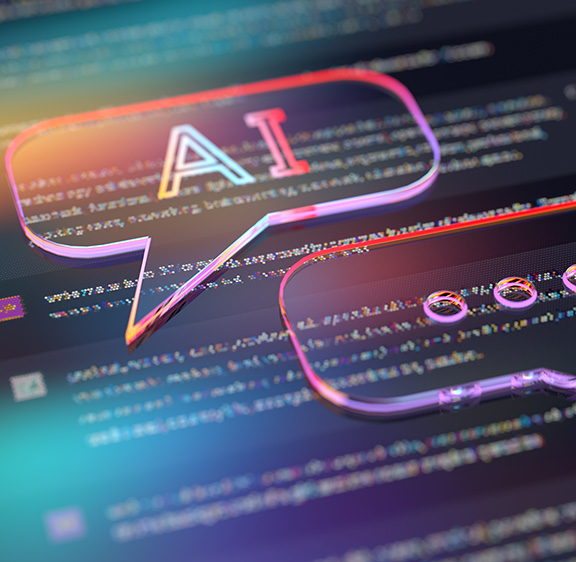Although early GenAI technologies date back to 2017, incredible progress has been made in the last 12 months, marked by the launch of GPT-4, Google Gemini, Amazon Bedrock, Meta Llama, and a flourishing array of startups such as Mistral. This vibrant innovation in GenAI has overshadowed all other tech advances in the media, despite significant progress in cloud computing, the Internet of Things (IoT), and spatial computing technologies over the year.
As we progress in 2024, what technology trends can we expect in the months ahead? Based on expert communities at Eviden, here are 5 predictive trends for 2024 and 3 rules for success in the times to come. Not surprisingly, they focus on AI.
GenAI Trends in 2024
Trend #1 – We definitively enter the AI era.
While AI technologies are not new, this year definitely marks a threshold. The advances of 2023 build on a decade of innovation since the end of the AI winter in 2012, fueled by growing computing power with GPUs and the cloud, and the availability of vast amounts of data from the Internet. This also builds on the rapid progress of algorithms, surpassing previous deterministic technologies such as Machine Learning and Deep Learning (ML / DL), with the new transformers’ ability to generate new artifacts such as text, images, videos, and ultimately new materials.
After the 1960s’ mainframe era, the 1980s’ distributed computing era, and the 2000s’ social, mobile, analytics, and cloud era, it’s clear that we are now entering the AI and autonomous machines era of the 2020s. This is a new demonstration of the “emergence” phenomenon: beyond a certain threshold, we move from linear to exponential progress. This will have dramatic consequences in customer interactions, operations, trust, and even business models. As usual, the most agile organizations, not necessarily the strongest, may thrive in this revolution.
Trend #2 – We’re still at the early stage of the innovation curve.
Regardless of the impressive progress in the past year, we are probably still at the beginning of the journey. From new use cases in each industry to new development modes with copilots, new models from multiple startups, new AI specialized processors – including quantum – and new security technologies, vibrant innovation is not slowing down but accelerating.
Innovation is coming from all fields, not only in GenAI but also in traditional AI domains and promising research fields such as Liquid Neural Computing and others. With particularly vibrant and flourishing open source communities, which successfully compete with traditional large ISVs, this once again demonstrates the power of open innovation. To succeed in this evolving landscape, being open to all possibilities but focusing primarily on business outcomes will be essential to avoid the mirage of techno-centric solutionism.
Trend #3 – The future of AI will be an ecosystem game.
While GenAI leaders have already emerged over the past two years, it’s clear that the landscape may still undergo significant changes. More than ever, the future is open. Even as the arms race in large models accelerates with hyperscalers and large governments at the forefront (an arms race to which we contribute with our Jupiter Exascale system, likely to be the most powerful AI supercomputer in the world), innovations will come from multiple fronts. These include smaller and more specialized models, AI at the edge, and more.
The move to multimodality – the trend of large models subdividing into smaller models, coordinating to answer requests – is only the tip of the iceberg. Contrary to some preconceived ideas, the future of AI may not lie only in mega GenAI applications. It will be in multiple models capable of interoperating, cooperating, or even competing with each other to provide the best services. Just as the human brain has evolved into multiple specialized functions and then developed collectively through social interaction among individuals, the future of AI is probably an ecosystem game. It will be essential to view AI strategies from this open perspective.
Trend #4 – Your data will be your strategic asset.
How can one compete in this upcoming exponential world where intelligence and possibilities will flow? More than ever, the difference will lie in what you actually know better than others and how you intelligently leverage it.
In one word, it all comes down to your data and how you exploit it with AI to improve customer experience, optimize operations, or reinvent business models.
Companies that can aggregate their unique data quickly, efficiently, and with good quality will hold a powerful competitive advantage. While the GenAI toolset may become commoditized and accessible to all, the true value will lie in the data and its intelligent application. Therefore, the ability to gather, organize, and utilize your data effectively will be the cornerstone of success in the GenAI era. This underscores the critical importance of focusing on data governance, quality, and accessibility as key strategic priorities.
Remember, the AI tools are like powerful engines, but it’s the quality of your fuel (data) that determines how far and how efficiently you can go.
All of that, and most importantly, in a trusted and secure way. It’s no surprise that a large part of the AI battle is moving toward intellectual property, security, and responsibility topics.
Trend #5 – Agents will probably be the next disruptive step.
What better demonstration of this trend toward ecosystem thinking than the rise of autonomous agents?
The emergence of experiments such as AutoGPT, BabyAGI, and others demonstrates what the future could be: leveraging LMM to not only perform individual tasks but also automate complex multi-step tasks, with autonomy, reactivity, pro-activeness, and social ability. Taking this further, automatically breaking down queries into subtasks, distributing each through APIs to the most specialized modules everywhere, and iteratively reevaluating and adjusting actions based on results until the overall goal is achieved. This may not only revolutionize enterprise processes but also business ecosystem processes, with the prospect of giving way to autonomous businesses. It’s probably still 4 or 5 years ahead. But the future is often closer than we think.
Learn more about the role of autonomous agents with Eviden’s executive paper on this topic.
The road ahead: Three rules for tomorrow
So, how do you succeed in this AI era? AI won’t revolutionize the basics of business, it will only expand them on a larger scale, and faster.
Gear up to brace the future with these 3 rules and craft sustainable enterprise strategies in the year ahead:
- Assess and optimize data strategies to grow, protect, and even monetize your key competitive advantage in this new era: knowledge.
- Accelerate experiments with AI, focusing on business rather than technology outcomes, but examining all tech dimensions to be ready for different possibilities, across the stack, and along the digital continuum, from private high-performance analytics infrastructures to cloud and edge. Ensure you build the most appropriate mix of technologies for each use case to optimize the outcome-cost-performance ratio.
- Place trustworthiness at the core of your approach. This is exactly what we have strived to develop with our large customers within our GenerativeAI acceleration program. In fact, Eviden has been recognized among the leaders in the first GenAI service providers panorama, published at the end of 2023 by HFS.
With our unique breadth of capabilities, we aim to enable our customers to leverage the best of data and tech to expand their possibilities.
Want to know more about how your business can leverage this for sustainable and improved returns?
Get in Touch!
Contact us today for a tailored solution that matches your needs. Let us provide you with exceptional service and expertise. Experience the difference with Eviden!




